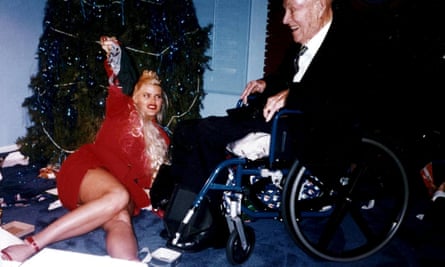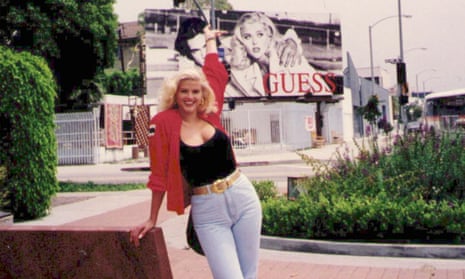In the recent wave of documentaries demanding justice for the tragic blondes of the 1990s – Britney Spears, Princess Diana and Pamela Anderson among them – it’s unsurprising to find a new film about Anna Nicole Smith next in the queue.
Anna Nicole: You Don’t Know Me, a Netflix production directed by Ursula Macfarlane, revisits the life of the titular model and Playboy centerfold best known for marrying an octogenarian billionaire, then very publicly losing it all; in 2007, she was found dead in a Hollywood, Florida, Hard Rock hotel at the young age of 39, having taken a toxic mixture of methadone, Valium and a variety of sedatives. Diverging from the precedents set by the Britney and Diana films, however, this new documentary treats Smith less as a powerless victim of the media than the savvy protagonist of her own story. “She was a hustler,” Macfarlane tells the Guardian. “She made things happen on her own terms.”
Smith, born Vickie Lynn Hogan, began her life in the working-class, God-fearing town of Mexia, Texas. “She was born beautiful,” says a voiceover from her late mother, a police officer named Virgie Mae Hogan, as she recalls memories of grown men following her child through the local shopping mall. As an adult, Smith rarely spoke of her childhood except to say that she hated her abusive mother, and Macfarlane pieces together these early years with interviews with her subject’s brother and her uncle. From a young age, they say, Smith was rebelliously enterprising, fixated on gaining both attention and money. She dropped out of high school to get a job at a fried chicken restaurant, where at age 17, she married a co-worker who allegedly kept her locked inside the house. She gave birth to her son Daniel to soothe her own loneliness, then took off with him in pursuit of fame and fortune when he was six months old.
“She had an incredible work ethic,” recalls a former co-worker simply known as Missy who witnessed Smith on her early ascent to fame. Smith had modeled her Hollywood persona after the humor of Carol Burnett and the sex appeal of Marilyn Monroe, and played a record of Diamonds Are a Girl’s Best Friend on her first Playboy photoshoot to soothe her camera-shyness. Later revealed to have been lovers, Missy and Smith had met working at a Houston strip club called The Executive Suite, where Missy initially though she was taking a beautiful young novice under her wing. She quickly realized what becomes a recurring theme throughout the film: “No one needed to give her any pointers on how to attract a man … She doesn’t need a lot of help manipulating anybody.”
Smith first met the billionaire oil tycoon J Howard Marshall at the strip club in 1991, when he was 86 years old and she was only 23. Media treatment of their relationship had presented Smith as an opportunistic gold digger in Macfarlane’s mind, but during the film-making process, “one of the things that really surprised me was that their relationship, regardless of the distance in decades, was actually genuine,” the director says. “It was love, whatever love means, and it felt very important for us to set the record straight.”
The film approaches Smith and Marshall’s relationship with a measured tenderness, offering montages of the couple’s personal photographs and recordings of affectionate phone calls, plus home movies of loving exchanges between Marshall and Smith’s son. (As for how the film-makers got them, says producer Alexandra Lacey: “We can’t disclose the source of those, I’m afraid.”)
The film is largely sympathetic to the titular blonde bombshell, touching only briefly on the negative aspects of her marriage. “She was getting to where she was no longer grateful to Mr Marshall, just treating him like an ATM,” Missy says, recalling a change in Smith’s formerly warm-hearted personality as she developed an addiction to painkillers. Footage of a tearful Smith testifying her love for her late husband resounds with a heartfelt authenticity, particularly because she was known for her poor acting skills: “It wasn’t a sexual, ‘Baby oh baby I love your body’ type of love. It was a deep ‘thank you’ for taking me out of this hole, and ‘thank you for saving my life’.”

Marshall’s death in 1995, just 14 months after their wedding, marks an inflection point in the film where Smith’s upward trajectory quickly turns into a downward spiral. Despite the majority-woman jury, she lost her highly publicized legal battle over her late husband’s $1.6bn fortune to his son, Pierce Marshall. “She didn’t lose because she was a gold digger,” says Pierce’s lawyer Rusty Hardin. “She lost because of who she was.” Marshall had spent an estimated total of $14m on Smith hoping that it would be enough to support her after his death. On the witness stand, she described expenses “that the average person would find ludicrous”, Hardin adds. “It did not matter if it was alcohol or sex or drugs or food, she was a glutton”
Despite Macfarlane’s attempts to portray Smith as a sympathetic character, the rest of the film unfolds as chaotically and cringe-inducingly as it did in real life, from her short-lived reality TV show, to the custody battle over her infant daughter, to the tragedy of her son Daniel’s fatal drug overdose. Without the PR and management infrastructure Marshall had put in place for her, Smith’s career devolved into a series of clownish, visibly drug-addled public appearances.
“Throughout her life, she tried to be what she thought other people wanted her to be,” producer Alexandra Lacey says. Consequently, Smith also turned out to be a thoroughly unreliable narrator; her stories of childhood abuse were actually stolen from Missy’s life in order to garner attention and sympathy.
The real Anna Nicole Smith is a figure of many contradictions, says Macfarlane, “and we’re grateful to have had the time and the space to dig down and pull out all the nuances of someone who is extremely complex”. While her film presents few revelations about its subject, the director values the opportunity to revisit the tabloid era of the 90s “with fresh eyes”.
“If [Smith] were forging her narrative today, I really like think that she’d be living a joyous social media life where she was in control of the narrative,” Macfarlane says. “In the post-#MeToo world, I want people watching this film to come away with more empathy and less judgment.”
Anna Nicole: You Don’t Know Me is now available on Netflix
